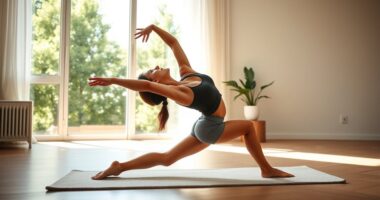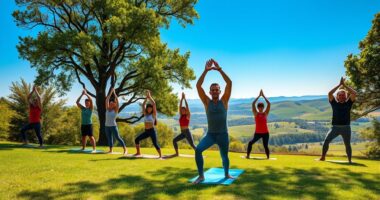To start indoor cycling at home, choose a sturdy bike that supports your size and fits your space. Set up in a well-ventilated area with enough room to move comfortably. Learn basic cycling principles like proper posture and resistance control. Create a motivating environment with good lighting, music, and tracking tools. Start with beginner routines and gradually increase intensity. Keep your equipment maintained, stay consistent, and you’ll enjoy your rides more. Continue to explore ways to optimize your experience and stay motivated.
Key Takeaways
- Choose a sturdy, adjustable indoor cycling bike that fits your space and supports your comfort and fitness goals.
- Set up a dedicated, well-ventilated area with proper lighting, ventilation, and space for safe movement.
- Learn basic cycling terminology, proper posture, and technique to prevent injury and maximize effectiveness.
- Incorporate motivating music, hydration, and tracking tools to enhance your workout experience and monitor progress.
- Start with beginner routines, gradually increase intensity, and stay consistent to build endurance and enjoy your indoor cycling journey.
Choosing the Right Indoor Cycling Equipment

Choosing the right indoor cycling equipment is vital to guarantee a safe and effective workout. Start by selecting a sturdy bike that supports your weight and fits your height comfortably. Many bikes now come with built-in features that enhance your experience, like adjustable resistance and comfortable seats. To stay motivated, consider bikes compatible with virtual classes, which let you join live or on-demand sessions right from home. Invest in essential cycling accessories, such as a water bottle holder, a towel, and clip-in shoes, to improve comfort and performance. These accessories help you stay focused and prevent distractions during your ride. Selecting equipment with tuning options can help optimize performance and ensure your bike meets your specific fitness needs. Proper equipment ensures safety, boosts motivation, and creates an enjoyable cycling experience tailored to your fitness goals. Additionally, paying attention to ergonomic design can reduce strain and increase comfort during longer rides. For optimal comfort, choose a bike with adjustable components that can be customized to your body’s needs. Incorporating user feedback can further assist in selecting equipment that best fits your individual requirements.
Setting Up Your Indoor Cycling Space
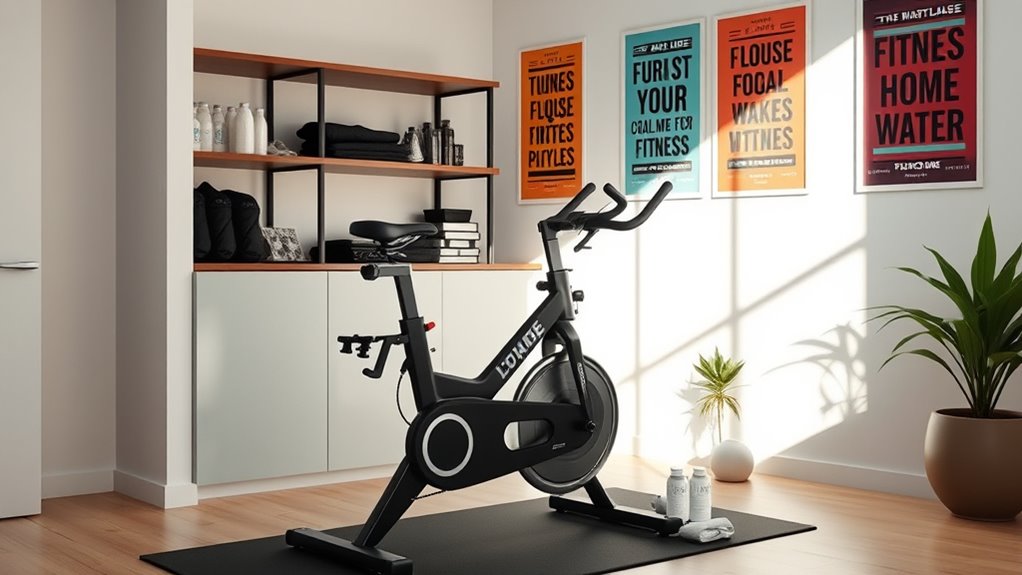
To create a comfortable and safe indoor cycling space, choose an area with enough room for movement and proper ventilation. Make certain to have all the essential equipment nearby, like a mat, towel, and water bottle. Setting up thoughtfully ensures your workouts are effective and enjoyable from the start. Additionally, consider incorporating automation technologies to monitor your progress and optimize your training sessions. Understanding best free keto diet app options can help you stay motivated and track your fitness journey more effectively, even when focusing on indoor cycling. Creating an environment that fosters motivation and consistency can significantly enhance your workout experience. For added inspiration, exploring popular fitness trends can help keep your routine fresh and engaging.
Optimal Space Selection
Selecting the right space for your indoor cycling setup is essential for safety and comfort. Focus on an area with good space acoustics to minimize noise disturbances and keep your workouts focused. Choose a spot that provides enough room for safe movement around your bike, avoiding clutter that could cause accidents. Lighting ambiance matters too—natural light can boost motivation, but if that’s limited, ensure you have sufficient, adjustable lighting for visibility and mood. Avoid overly bright or dim areas that strain your eyes or diminish focus. The space should be well-ventilated to keep you cool and comfortable during intense sessions. Incorporating proper space optimization techniques can help you find a neighborhood with convenient access to parks or community centers to support your fitness journey. Additionally, considering organization strategies can help maintain a clutter-free environment, making your workouts more enjoyable. By carefully choosing a spot that balances acoustics, lighting, and airflow, you create an inviting environment that enhances your indoor cycling experience.
Essential Equipment Checklist
Creating the right environment for indoor cycling starts with gathering the necessary equipment to guarantee safety and effectiveness. Essential items include a sturdy indoor cycling bike and comfortable cycling apparel that allows free movement. Ensure your space has proper ventilation and a non-slip mat beneath your bike for stability. To keep motivated, prepare music playlists that energize you and enhance your workout experience. Don’t forget a towel and water bottle to stay hydrated and wipe away sweat. A good pair of cycling shoes can improve your performance, while a heart rate monitor helps track progress. Proper lighting and minimal distractions also contribute to a focused session. Incorporating hybrid bikes into your routine can provide a versatile workout option if you prefer outdoor riding or mixed terrains. Additionally, investing in top-rated accessories can further enhance your indoor cycling experience. Using performance tracking devices can help you monitor your improvements over time. It’s also beneficial to consider the environment of your workout space, ensuring it’s well-ventilated and free from pollutants for a healthier exercise session. With these essentials in place, you’ll create a safe, motivating environment perfect for your indoor cycling journey.
Understanding Indoor Cycling Basics and Terminology
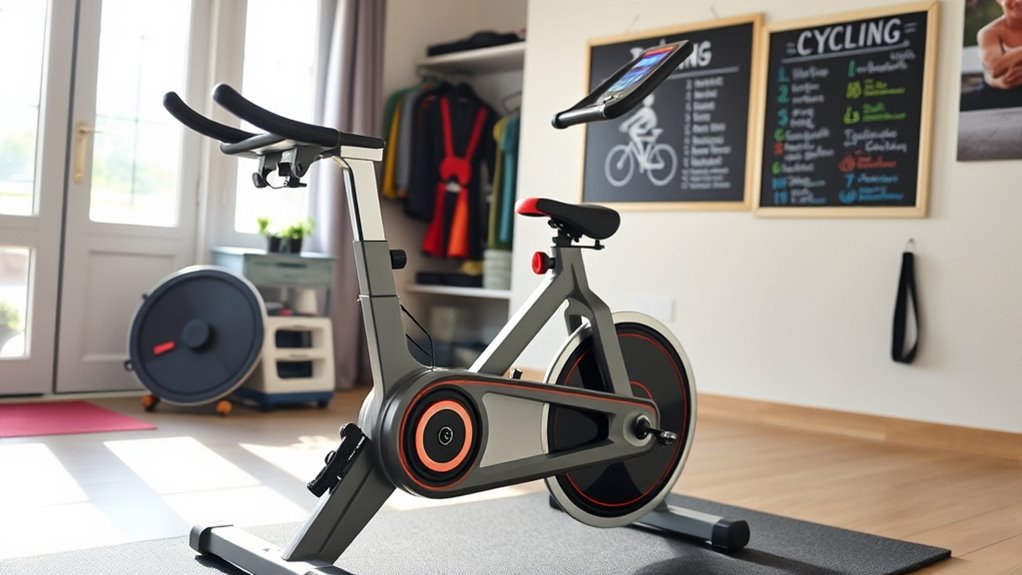
To get the most out of your indoor cycling sessions, you need to understand some key basics like pedal mechanics, resistance, and proper posture. Knowing the common terms used during classes or workouts can also help you follow along and improve faster. Once you’re familiar with these points, you’ll ride more confidently and effectively. Incorporating proper technique can further enhance your performance and reduce the risk of injury. Additionally, understanding industry transformations such as AI automation and innovative solutions can inspire you to adapt and find new ways to stay motivated in your fitness journey. For example, the integration of advanced bike tuning options can optimize your cycling experience at home. Being aware of performance tuning principles can help you customize your equipment for better results.
Pedal Mechanics and Resistance
Understanding pedal mechanics and resistance is essential for getting the most out of your indoor cycling workouts. When you pedal, your bike’s pedal resistance determines how hard it is to turn the pedals. Adjusting resistance helps simulate different terrains and intensities. Many bikes feature gear shifting, allowing you to change resistance levels smoothly. Shifting to higher gears increases pedal resistance, making your muscles work harder, while lower gears ease pedaling. Pay attention to how resistance feels; maintaining a steady, manageable pace is key to effective training. Properly controlling your pedal resistance helps prevent fatigue and injury, making your workout more efficient. Mastering gear shifting and resistance settings ensures you can tailor each session to your fitness level and goals. Being aware of the resistance mechanism is crucial for optimizing your workout and avoiding overexertion. Additionally, understanding how heat pumps operate can help in maintaining your indoor cycling environment for optimal comfort and temperature control. Recognizing the AI processing power in your device can also enhance your interactive workout apps, providing smoother and more responsive experiences.
Cycling Posture and Form
Getting your cycling posture right is essential for comfort, efficiency, and injury prevention during indoor workouts. Maintaining proper form helps you ride smoothly and avoid strain. Focus on keeping your back straight, shoulders relaxed, and elbows slightly bent. Your hands should rest lightly on the handlebars, avoiding unnecessary tension. To improve your cycling posture:
- Keep your hips level and aligned with your shoulders
- Engage your core to support your spine
- Ensure your knees track directly over your pedals
- Pay attention to your cycling product to ensure optimal fit and comfort
- Regularly checking your cycling posture can prevent common issues and maximize workout benefits. Incorporating proper bike fit can also significantly improve your riding experience. Practicing proper form maximizes power transfer and reduces fatigue. Adjust your saddle height so that your knee has a slight bend at the bottom of each pedal stroke. Additionally, maintaining awareness of your body alignment during cycling can further enhance comfort and efficiency. Remember, consistent attention to your cycling posture enhances your overall indoor cycling experience.
Common Terminology Used
Familiarizing yourself with common indoor cycling terms can make your workouts more effective and less confusing. One key term is cycling cadence, which refers to how fast you pedal, usually measured in revolutions per minute (RPM). Maintaining the right cadence helps optimize your workout and prevent injury. Another important term is flywheel resistance, which determines how hard it is to turn the pedals. Adjusting the resistance allows you to simulate different terrains and intensities. Understanding how to modify both your cadence and resistance helps you tailor each session to your fitness level and goals. Knowing these basics ensures you get the most out of your indoor cycling workouts and stay motivated as you track your progress.
Creating a Safe and Comfortable Riding Environment
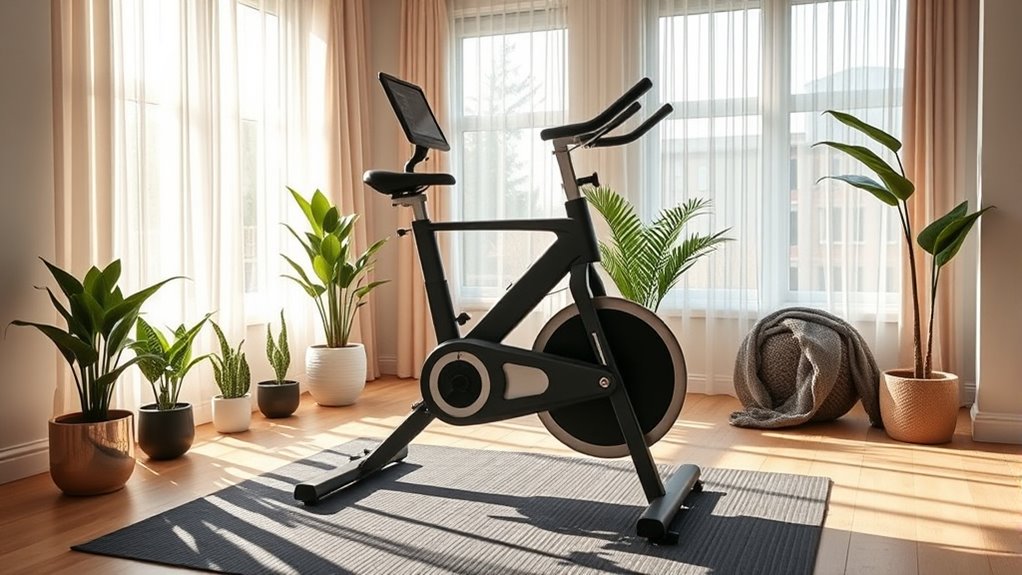
Creating a safe and comfortable riding environment is essential for a successful indoor cycling experience. To guarantee safety precautions are in place, check that your bike is properly assembled and stable. Comfort enhancements can make your ride more enjoyable and help prevent injuries. Consider the following:
- Place your bike on a non-slip surface or mat to prevent slipping
- Adjust the seat height and handlebar position for proper ergonomics
- Keep your workout area well-lit and free of clutter to avoid accidents
These steps help create a secure setup where you can focus on your workout without distractions. Prioritizing safety precautions and comfort enhancements ensures you stay safe, motivated, and ready to ride efficiently during every session.
Developing a Beginner-Friendly Workout Routine
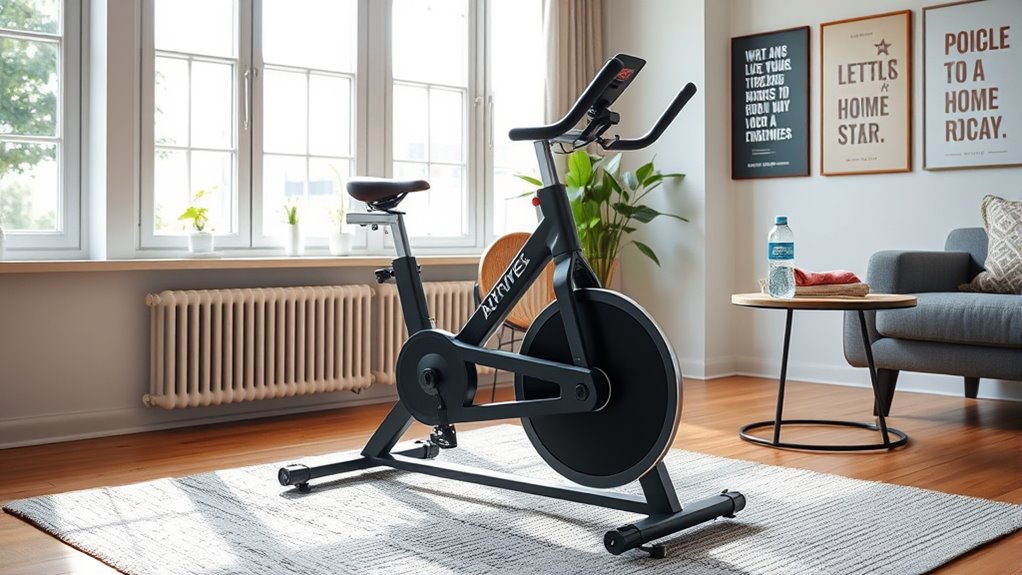
Starting with a simple, manageable routine helps you build confidence and consistency in your indoor cycling journey. Focus on gradually increasing your workout duration and intensity. Incorporate interval training to boost your endurance and keep your workouts engaging. For example, alternate between 30 seconds of high effort and 1 minute of recovery, repeating this cycle for 10-15 minutes. As you progress, extend your interval sessions or add more challenging intervals. Remember to warm up before each session and cool down afterward. Keep a steady pace during recovery periods to avoid burnout. This approach helps prevent injury and keeps you motivated. Consistency is key, so aim for 3-4 sessions per week, adjusting your routine as your fitness improves.
Incorporating Motivation and Tracking Progress
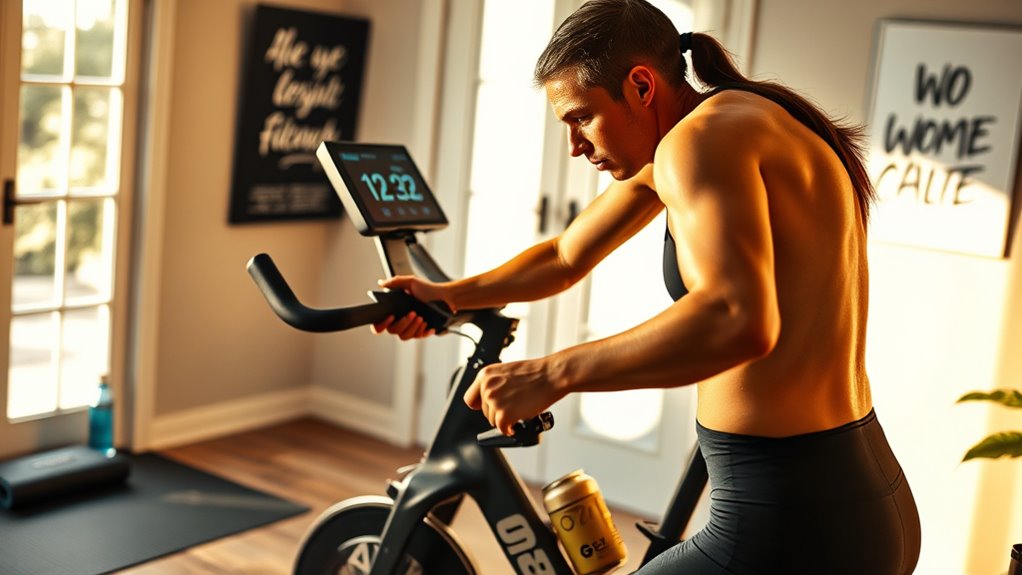
To stay motivated and see your progress clearly, it’s essential to set specific goals and track your workouts consistently. Motivational strategies like setting mini milestones, rewarding yourself for achievements, and visualizing your success help maintain momentum. Progress tracking keeps you accountable and highlights your improvements over time. Consider using a fitness app or journal to log each session’s duration, intensity, and how you felt. This record allows you to identify patterns and make adjustments as needed. Additionally, sharing your progress with friends or online communities can boost motivation through accountability and encouragement. Remember, celebrating small victories along the way helps sustain your enthusiasm and keeps you committed to your indoor cycling journey.
Maintaining and Caring for Your Equipment
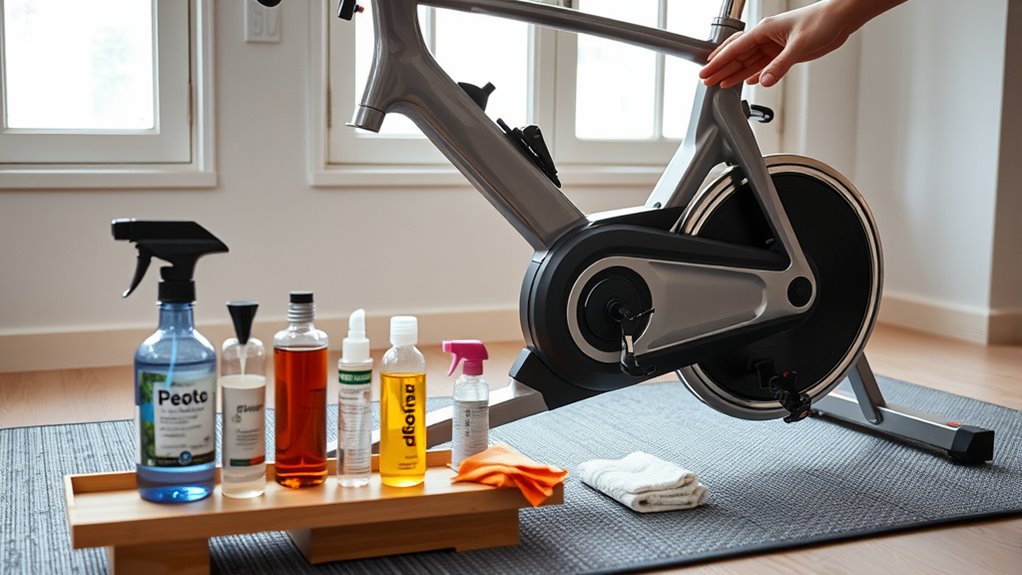
Keeping your indoor cycling equipment in good condition is essential for safe and effective workouts. Regular bike maintenance ensures smooth operation and prolongs your equipment’s lifespan. Proper equipment cleaning removes sweat, dust, and grime that can cause rust or damage. To help visualize, here’s a quick overview:
| Maintenance Task | Frequency |
|---|---|
| Wipe down the bike | After every ride |
| Check tire pressure | Weekly |
| Lubricate moving parts | Monthly |
| Inspect bolts and screws | Every 2 weeks |
| Deep clean the frame | Monthly |
Consistent bike maintenance and equipment cleaning keep your indoor cycling experience safe, enjoyable, and efficient. Stay attentive to these tasks to maximize your workout performance.
Tips for Staying Consistent and Enjoying Your Rides
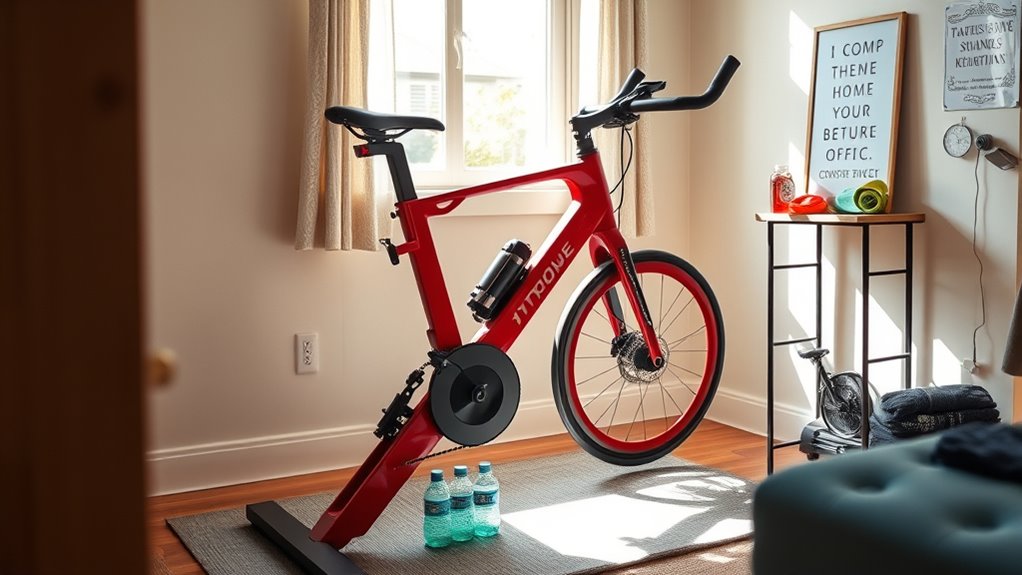
Regular maintenance helps make certain your indoor cycling workouts stay safe and enjoyable, but staying motivated over time can be just as important. To keep your rides consistent and fun, focus on finding motivation and establishing routines. Set specific goals, like improving stamina or completing a certain number of rides weekly. Keep your workouts engaging by varying intensity and trying new routes or music. Make your routine stick by scheduling rides at consistent times and creating a dedicated space. Remember, motivation can dwindle, so celebrate small wins and track your progress.
- Find a workout buddy or join online communities
- Mix up your routines to prevent boredom
- Reward yourself for milestones reached
Frequently Asked Questions
How Do I Choose the Best Indoor Cycling App or Program?
When choosing the best indoor cycling app or program, consider how it supports your goals. Look for options with heart rate monitoring to track your intensity and progress. Prioritize apps that offer workout customization, so you can tailor sessions to fit your fitness level and preferences. Read reviews, explore free trials, and pick one that motivates you, ensuring you stay engaged and see results in your indoor cycling journey.
What Are Common Mistakes to Avoid as a Beginner?
As a beginner, you should avoid common mistakes like neglecting a proper bike fit, which can cause discomfort or injury, and skipping consistent hydration, leading to fatigue. Don’t rush into intense workouts; instead, start slow and gradually increase intensity. Remember to listen to your body and take breaks when needed. Staying mindful of these mistakes helps prevent injuries and makes your indoor cycling experience more enjoyable and effective.
How Can I Prevent Saddle Discomfort During Long Rides?
Think of your saddle as your riding throne—comfort is king. To prevent discomfort on long rides, guarantee your saddle padding offers enough cushion without slipping into softness. The proper fit is your armor; adjust the saddle height and angle to match your body’s contours. When your saddle feels like an extension of you, every pedal stroke becomes a smooth, enjoyable journey, not a painful chore.
What Should I Do if I Experience Dizziness or Nausea?
If you feel dizziness or nausea during your ride, stop pedaling and sit upright to stabilize yourself. Use lightheadedness remedies like deep breathing and make certain you’re properly hydrated with hydration tips such as drinking water before and after riding. Take a break, cool down, and if symptoms persist, consult a healthcare professional. Listening to your body is key to safe indoor cycling sessions.
How Do I Integrate Strength Training With Indoor Cycling?
Pairing power-packed strength training with your cycling routine creates a cycling synergy that boosts your balance and builds your body. You can alternate days or integrate quick strength sessions, focusing on core and leg muscles. Use resistance exercises like squats or lunges to strengthen muscles used in cycling. This balanced blend improves endurance, enhances performance, and prevents injury, turning your workout into a well-rounded, winning wellness routine.
Conclusion
Starting indoor cycling at home is a great way to boost your fitness, even if you’re worried about the cost or space. With the right equipment and a little setup, you can enjoy effective, fun workouts anytime. Remember, consistency beats intensity—so don’t stress about perfect rides. Just enjoy moving your body and celebrating progress. Before you know it, indoor cycling will become a rewarding part of your daily routine!


